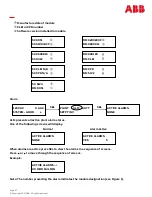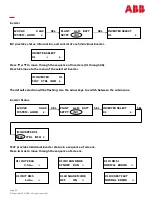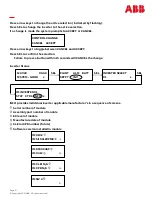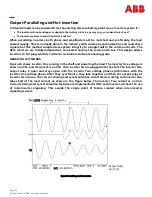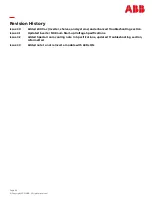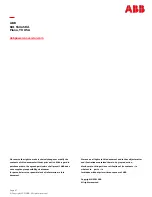
Page 61
© Copyright 2021 ABB. All rights reserved.
Table 12 Troubleshooting
-
Corrective Actions
Condition
Possible Cause
Corrective Action
3.
Turn ON CB1 of one shelf.
4.
Observe whether operation is normal or over voltage.
5.
Turn OFF CB1.
6.
Repeat for steps 3 through 5 for each shelf, individually.
7.
Remove all Inverters from a shelf observed in step 4 as over
voltage.
8.
Insert one inverter.
9.
Observe whether operation is normal or over voltage.
10.Remove the Inverter.
11.Repeat steps 8 through 10 for each inverter in the shelf
12.Repeat from step 7 for each shelf.
13.Replace failed Inverters observed as over voltage in step 4.
14.Reinsert all inverters.
15.Operate MBS to THE INVERTER position
or
Turn ON all load circuit breakers to reconnect all loads to the
system.
16.Turn ON system per the Shelf Turn On and Operational
Checkout section.
Inverter Standby LED ON
Initialization in process
Wait for initialization to complete.
Manual Standby
Manually return the Inverter Mode to RUN.
menu path: INV > Inv # > CTRL > INV MODE
-
RUN > ACCEPT
CB1 AC Load
Disconnect OPEN
Close CB1.
Clear load fault if necessary.
Failed Inverter
Replace Inverter.
Controller Minor LED ON
Plant Frequency
DM Frequency Error may cause a false Plant Hz Fault.
Inverter Frequency Error may cause a Plant HZ Fault and Inverter
Frequency error.
DM Frequency Error Determination:
1.
Confirm Plant HZ Alarm menu path: PLANT > STAT > PLANT HZ
> FAULT
2.
Check Plant Frequency menu path: PLANT > STAT > PLANT HZ
3.
Check Inverter Frequency of each Inverter menu path: INV > Inv
# > STAT > FREQUENCY
4.
Check Output Frequency with an accurate, calibrated meter.
5.
If all Inverter FREQUENCYs and measured Output
Frequency are 60 ±0.2Hz
Replace the DM.
Otherwise, proceed.
Inverter Frequency Error Determination:
NOTE: This procedure will result in loss of power to the load
unless load

